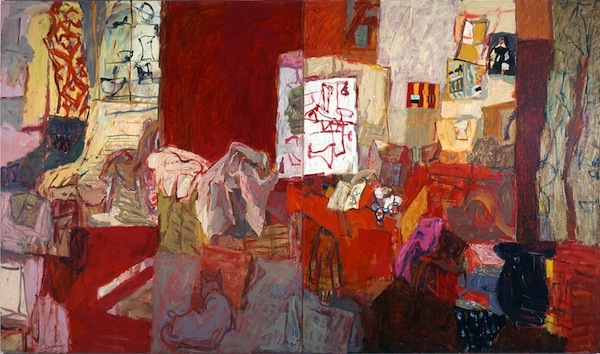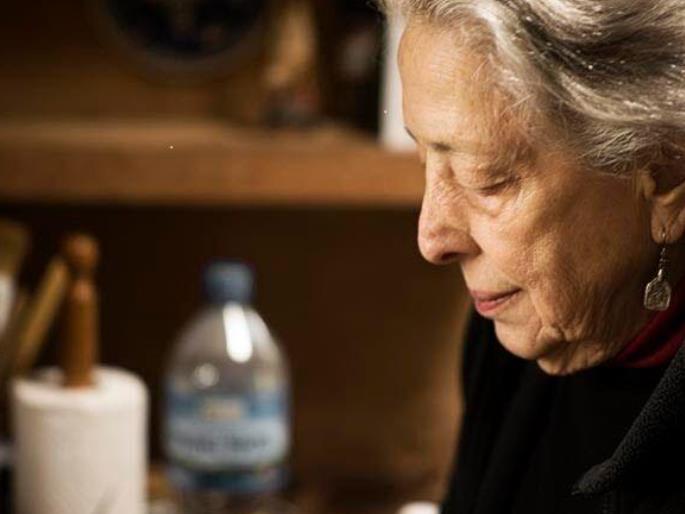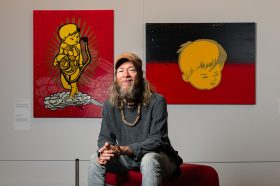Elisabeth Cummings; image SH Ervin
The announcement of a survey exhibition is usually accompanied by the words ‘long overdue’.
For a long time there was a culture within the museum and gallery sector that put the emerging artist on the ‘hot thing’ pedestal at the expense of more established artists. Adding to that “mid-career desert” – what that blind spot had come to be thought of – state institutions were faced with the increasing pressures of efficiency measures and the need to deliver ecstatic attendance figures to funding bodies and government tourism agencies.
Simply, hi-vis, hi-energy exhibitions were going to guarantee more people through the doors than a solo by a senior artist who was somewhat niche in appeal. The survey exhibition, consequently, was pushed into the corner, to be dealt with later.
Mid-scale metropolitan, and some regional, galleries picked up the slack and started to garner a reputation for having the capacity of putting on serious survey exhibitions. Some were even printing substantial publications to support those exhibitions.
While this trend continues, arguably there has been a swing back to more balanced programing at the majors, perhaps a response to push-back from the sector and a call for generational and gender balance.
Heck, it has almost become fashionable to put on a mid to late-career survey this year.
Pedro de Almeida, Program Manager, 4A Centre for Contemporary Asian Art made the observation: ‘In “Adminaustralia” (a juicy descriptor I’ve recently co-opted from the artist Amala Groom) we so often draw up categories of “emerging”, “mid-career” and “established” which serve a useful purpose as short-hand for artificial strictures that life has a funny way of not complying with.
‘I suspect the impulse to stage a survey exhibition most commonly arises from a combination of a desire to assess, praise and continue to question an artist’s practice and contribution to the development of a form, yet I also believe that conscious decision making is always underscored by deeper, subconscious rhythms at play in a culture that somehow call for what is needed when it is needed.’
De Almeida has curated Dacchi Dang: An Omen Near and Far (9 June – 30 July), the first survey exhibition of one of the preeminent Vietnamese-Australian artists working today, which opens next week.
Picking up on that zeitgeist and the survey’s new value, ArtsHub decided to ask a number of curators about the shift, and why is the survey exhibition so important?

Dacchi Dang, Self-portrait II (from the series Full Circle), 2009, pigment on photo rag; image courtesy the artist.
Why surveys are important
All of our curators shared the view that survey exhibitions were important for their role in contextualising a large body of work by an artist. As Mark Bayly, Assistant Director, Exhibitions and Collections, Canberra Museum and Gallery (CMAG) described, ‘it’s an opportunity to take stock of a mature artist’s career’.
That is often a cathartic experience for an artist. But Bayly believes that the survey is also a moment of revelation for the audience, to share what a creative journey might look like.
‘[They] make us re-assess what we think we know about an artist’s work and contribution to the visual arts,’ said Jane Watters, Director, SH Ervin Gallery.
Michael Dagostino, Director Campbelltown Art Centre (CAC) added: ‘To understand an artist’s practice from the beginning is like learning a new language. A solo or group exhibition only has the capacity to reveal single words of the artist, while a survey has the power to bring those words together to form the broader language of artist practice.’
Bayly recently curated the survey show of the Canberra-based, internationally recognised glass artist Kirstie Rea, The land – a 20 year survey (13 May – 20 August), while SH Ervin has presented back-to-back survey exhibitions by painters Peter Powditch and Elisabeth Cummings: Interior Landscapes (26 May – 23 July) in recent months.
CAC is mounting a survey of Manila-based Australian artist David Griggs, Between Nature and Sin (5 August – 15 October) curated by Megan Monte. ‘The survey explores the life of an artist living between two cultures and David’s ability to work collectively with both Philippine artists and the community,’ explained Dagostino.

David Griggs, The bleeding hearts club #3, 2006. Image courtesy the artist.
‘We were compelled to curate a survey exhibition as David’s exhibition history has been quite disparate; this is the opportunity to bring together a body of work created over 10 years,’ he said.
That idea was expanded upon by de Almeida: ‘Being able to track how an artist reflected, reconfigured and rejected ideas and sensations over time can reveal as much about an individual as about a wider culture in which an artist moved through.
‘In this sense, survey exhibitions are rather like a novel in their function: we are led through a mind’s interior perspective by a narrator, unreliable or otherwise, on what’s out there, in the world. And no matter how disjointed or abstracted the view, we can’t help but attempt to piece together narratives that might lead us to some kind of meaning.’
What these curators hint at is that survey exhibitions not only shed a light on an artist, but also on ourselves, and we have grown as a viewing audience.

Elisabeth Cummings, Journey through the studio 2004, Courtesy the artist and Arthur Roe Collection
Why are we suddenly valuing prolonged practice?
ArtsHub has scanned current programing and counted 20 survey exhibitions that are currently showing, or are soon to be mounted, with 45% of those surveys looking at women artists.
Among them are: Peter Powditch (SH Ervin), Elisabeth Cummings (Drill Hall, touring), Christian Thompson (MUMA), Kirstie Rea (CMAG), Dacchi Dang (4A), Louise Herman (MCA, touring), Patrick Pound (NGV), Brook Andrew (NGV), Robert Boynes (Drill Hall Gallery), and forthcoming: Jenny Watson (MCA), Hilarie Mais (MCA), Liz Coates (Drill Hall Gallery), David Griggs (Campbelltown Arts Centre) and Mazie Karen Turner (posthumous survey, Newcastle Art Gallery).
Recently ended surveys include: John Olsen (NGV, touring), George Gittoes (Penrith Regional Gallery and Hazelhurst Regional Gallery), Alex Seton (Newcastle Art Gallery), Michael Zavros (Newcastle Art Galelry), Bronwyn Oliver (Posthumous survey, TarraWarra Museum of Art), and Mandy Martin (Penrith Regional Gallery).
It begs the question, why now? Why are institutions valuing prolonged practice now to a level of dedicating program space? And, has that post-emerging void an artist seemingly falls into finally gone?
‘Why now?’ said de Almeida. ‘Probably because the critique of the unbalanced focus on and opportunities provided to younger artists that we’ve been hearing for a while has actually been heard and prompted reflection and re-prioritising from gallery and museum directors, curators and other people who have a hand in this kind of program decision making.
He added: ‘The swell, if that is indeed what has occurred, is heartening, but for every artist that gets a nod in this regard, many others deserving of attention wait patiently. There is always more work to be done.’
Charlotte Day, Director, Monash University Museum of Art (MUMA) responded: ‘You are spot on [regarding the swell]. It is important to support emerging artists of course, something we are committed to at MUMA, but there was, for an extended period, a palpable cult of the new. New never lasts very long, so I am pleased that there is a move away from that.’
Day has co-curated the first Australian survey of Indigenous artist Dr Christian Thompson, Ritual Intimacy (27 April – 8 July) with Hetti Perkins.
_2010_180dpi.jpg)
Christian Thompson, King Billy (Untitled 6); courtesy the artist
Dagostino made the point that survey exhibitions have always occurred, but that he felt they are becoming more important, thus more visible. Campbelltown Arts Centre has curated numerous survey exhibitions over the past six years.
Watters felt that another shift was in play. ‘In the past, exhibitions focusing on single artists were usually reserved for those artists who were no longer alive. Perhaps institutions felt that they needed the passing of time to determine the validity of an artist’s contribution but thankfully that has changed,’ she said.
Watters believes the rediscovery of survey exhibitions is also linked to a change in audience tastes. ‘How today’s audience appreciates visual arts has improved with education and profile, and institutions are certainly seeing the merit in celebrating artist’s careers during their lifetime,’ she said.
Bayly added to the conversation: ‘Changes in the commercial sector of the visual arts – with auction houses and consultants achieving enhanced market share – has possibly resulted in a more mature appraisal of established artists’ work. Consequently, audiences are becoming more informed about recent art history and this response is reflected in the programming undertaken by museums.’

Kirstie Rea, Remnant rhythm 2013; kiln-formed glass and found tool; CMAG, purchased with funds donated by Meredith Hinchliffe Fund 2013
What’s the criteria for a survey?
One of the sure salutes that a survey exhibition offers is acknowledgement of a sustained practice. Increasingly, it is difficult for artists to keep a professional career on track. The financial pressures of everyday life mean that as the years roll by post graduation, fewer and fewer artists continue their practice as their primary career.
Day said: ‘I wouldn’t say it is easy at all for Australian artists to sustain their practice, the market is modest and there are not so many opportunities across the board. It’s still very tough.’
Like Dagostino, for Day it was the trigger of distance that led her to curate Thompson’s survey.
‘Christian has spent extended periods studying and working overseas over the last ten years so the idea for this survey started with thinking about how those experiences may have shaped his practice … and informed his thinking about Australian history and ideas of cultural repatriation.’
She added that while Thompson’s photography is deeply celebrated, less is known of his video and sound works, and so another motivation was to give audiences a better sense of how these different media are mediums for his ideas.
For de Almedia, in terms of criteria, ‘looking back and looking forward is never mutually exclusive for any good artist; indeed, it’s a natural state. It should never be a nostalgic process nor self-important. Good surveys propose new connections; very good surveys slay shibboleth; bad ones are marked by vested interests that deny other voices, other rooms.’
He continued: ‘In Dacchi’s case, there’s much to be gained in surveying a practice at a time when an artist is pushing their work into another stage, as he is in the new work he’s been producing both following the Gillespie Bequest commission from the Australian War Memorial and his second return to Vietnam in February of this year.’
For Bayly, it was years of bonding over cups of tea with Rea, and talks about the landscape and its evocation of form and void in her work. He explained: ‘Essentially, my approach to curating this exhibition has been 20 years in gestation.’
He added that Rea’s exhibition is a good example of that life-long commitment and significant practice as an Australian artist, who is recognised internationally, but still is little known to the broader Australian public.
Bayley said: ‘If accomplished professionally, [the survey] becomes both an act of homage and interpretation.’
Watters added: ‘There are so many artists deserving of surveys and retrospectives and we assess each individual on their work. In the case of Cressida Campbell we held a survey after around 30 years of practice to coincide with a major book release whereas other such as Peter Powdtich have been around for over 50 years but have seemingly disappeared from public awareness over time and deserved a renewed focus.’
Warned de Almedia: ‘It’s important to keep in mind too that not all mid-career surveys are of the same stripe in terms of their objectives – certainly I’ve come across one or two that appear more as exercises in market development or status enhancement for that particular artist’s work, or a private or public collection strong in holdings of that artist, then an attempt at genuine, critical appraisal of the work in art historical terms or a broader cultural sphere.
‘Conversely, nor should a “mid-career survey” be a universal ambition – some artists, like a good punk band, make their indelible mark upon the world in a short, sharp burst and then disappear or simply move on. The Sex Pistols never needed a “best of” album,’ he finished.

Berceuse, 2017, three channel video installation, duration 5 min 25 sec, Christian Thompson/ Ritual intimacy, installation view/ Monash University Museum of Art, Melbourne 2017. Photo: Andrew Curtis
Are the majors doing enough?
De Almeida recognises that things tend to ebb and flow in museum programing, responsive to a whole myriad of influencing factors.
‘State institutions are big machines – they have heft but move slowly – but I don’t think that’s a limiting factor. Presenting one artist, one vision and, in effect, one story, is inherently a more narrow programming decision that leaves itself open to acquired tastes; audiences may or may not connect with an artist’s work, and therefore it’s a riskier proposition than a big group show with, as the saying goes, “something for everyone.” Well, that’s a theory.’
Dagostino added on the topic: ‘Some state institutions are producing important survey exhibitions of mid and late career artists, while others must do more. Rather than trying to be a gallery for all, they should make this one of their priorities as they are in a place to raise the profile of Australian artists and celebrate them through this context. The MCA has been leading the way in this regard as they have produced numerous surveys by Australian artists over the past years.’
Day said: ‘There is some crossover between the work of state institutions and the medium sized museums and galleries, such as when Emily Floyd had a survey at Heide and one at NGV in close proximity. But it does appear that the opportunity to work closely with artists on such surveys has been taken up by university museum sector and other institutions such as MCA and Tarrawarra, and contemporary art spaces such as Brisbane’s Institute of Modern Art too.
‘I think there is a lot of crossover but perhaps a greater desire to dig deeper in our sector, and a different set of priorities in terms audience engagement,’ she concluded.
Watters said: ‘I think that it varies from institution to institution and because major galleries program so far in advance they only have openings for a limited number of survey exhibitions. Galleries such as SH Ervin, which used to predominately focus on the past, has been able to regenerate and revitalise its programs by working with living artists in the presentation of survey shows.’
And Bayly sat counter to the commentary. He believes that state galleries are not totally remiss in presenting survey exhibitions by Australian artists, mentioning in particular surveys of Richard Larter (NGA, 2008) and Robert Jacks (NGV, 2014) as having an impact for him for their thoughtful curation.
‘Consequently, I’m unable to agree that the larger institutions aren’t presenting solo survey exhibitions,’ argued Bayly.
‘CMAG established a strong commitment to the presentation of survey exhibitions under previous director, Peter Haynes; Deborah Clark, Senior Curator of Visual Arts, CMAG, consolidated this approach.’
Prior to Rea’s survey, Clark curated a survey of painter Michael Taylor.
The bottom line is that the survey exhibition is again considered worthy programing. There is no longer tolerance for gender-skewed programing and, it would seem, that the late career survey exhibition is drawing good visibility, marketability and credibility – and contrary to past belief, are attracting solid attendances.
Long overdue, it may now just be a case of who’s next.
Kirstie Rea: the land – a 20 year survey is showing at Canberra Museum and Gallery 13 May – 20 August.
Interior Landscapes: Elisabeth Cummins Retrospective is currently on show at S. H. Ervin Gallery (26 May – 23 July). This exhibition is on tour from the Drill Hall Gallery (ACT).
Christian Thompson: Ritual Intimacy at Monash University Museum of Art (MUMA), 27 April – 8 July.
Dacchi Dang: An Omen Near and Far opens at 4A Centre for Contemporary Asian Art on 8 June and continues through 30 July.
David Griggs: Between Nature and Sin showing at Campbelltown Art Centre (NSW), 5 August – 15 October.
Brook Andrew: The right to offend is sacred is showing at NGV Australia 3 March – 4 June. Read review.
John Olsen: you beaut country is currently showing at the Art Gallery of NSW until 12 June.





